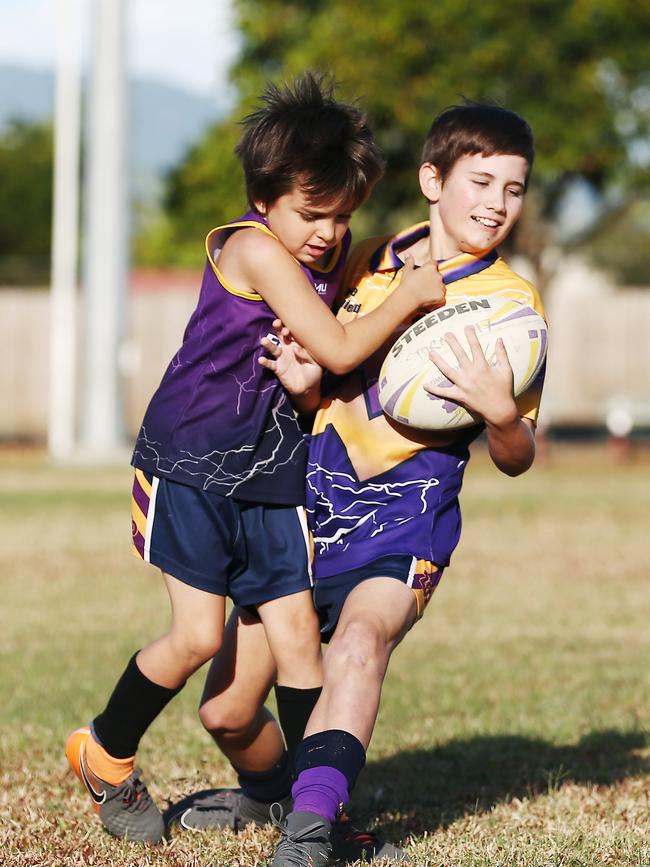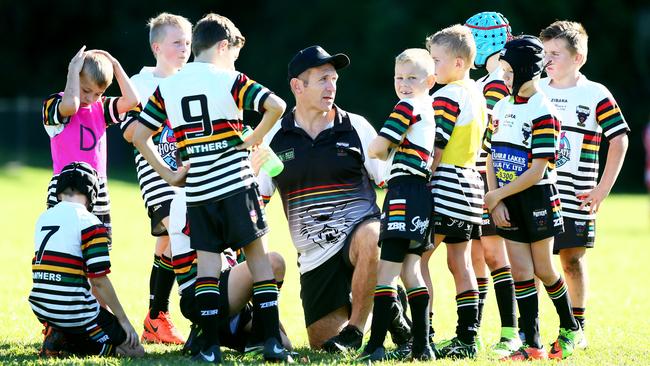NRL aims to bring kids back to the game by bringing the fun back to grassroots footy
Tired of having to fudge the junior numbers, the NRL is finally addressing the decreasing numbers of young players in the game. The problem? Us adults. The solution? More fun.
FOR years the NRL has trumpeted rubbery figures about the growth of the game.
The scientific term is called cooking the books or some such, and it helped sell the narrative rugby league was growing. This, even if anybody that has been near a junior game for more than five minutes could tell you they no longer see what they used to see.
The ways of cooking the books were many. Touch football registrations were included for a while, making it apples and oranges against the old figures. School coaching clinics counted as registrations, so often a junior player also registered for club football was counted twice, sometimes three times.
The recent boom of the women’s game has seen them camouflage the worrying loss of males playing the game, the NRL spruiking overall figures.

For those close enough to know it was a worrying trend. The big end guys were getting all the money. The grassroots were starving.
Nationally, in real numbers, there were 47,525 males registered in 2015 between 13 and 18. By 2017, just two years later, that number had dropped to 43,904.
That is a loss of 3621 players, or the equivalent of 213 teams. Disappeared.
Boys aged 7-9 went from 40,540 in 2015 to 38,518 in 2017. Boys 10-12 from 33,006 to 32,536.
But what if rugby league’s problem was me? What if it was you?
What if, in the absurd “I ain’t changing because the game’s going soft” mentality that afflicts the game among the higher levels, all us adults were the problem in junior rugby league?

Late last month the NRL flew in a fellow called Ken Martel. Martel works for America’s National Hockey League and when the NRL contacted him last year, intrigued by how the NHL had turned around its junior registration numbers, Martel saw a game with a lot in common with his game.
From 2000 to 2009 youth registrations in American hockey dropped 50,000. Hockey is a contact sport and faced many of the same problems the NRL is now facing, much of it driven around concussion and collision.
The overarching problem was the same: how do we get mums onside, and how do we make the kids want to play?
Martel was a gold mine of intelligence for the NRL.
The NHL’s problems were almost exactly the same as our game. And their response, to turn it around these past 10 years, might will provide the perfect template for the NRL.

Chiefly, the NHL found the problem with junior sport were, what else, but the adults. It’s nearly always the case.
Let us get involved and suddenly we can’t help ourselves.
And problem is most of the time we don’t even know it. We know what’s best.
Or pretend we do.
After studying leagues around the world, much like the NRL has done the past 18 months, Martel and the NHL found adults, whether in the form of junior coaches or sideline experts, were imposing their version of rugby league on their kids.
They were giving the kids what they wanted and telling the kids what they wanted, too.
It began with junior coaches secretly fantasising that if they won enough premierships in the under-12s then Craig Bellamy might somehow spot their unrecognised talent and hire them as an assistant at the Storm.
They were coaching for themselves, essentially not the kids.
The extension of that was junior coaches were recruiting the best players from other teams. At training they put all their coaching and attention into the better kids. Come the game, the best kids got all the game time.
Meanwhile Little Johnny sitting at the end of the bench soon walked away, disenchanted.

The NRL’s figures show that the under-8s have been in decline since 2000. And the drop-off from there is rapid.
About 20 per cent of eight-year-olds dropped out after one season. By age nine, 43 per cent had left the game and the number grew to 60 per cent by 11.
Rugby league cannot grow if the game’s foundation keeps getting smaller. At some point it reaches tipping point.
The NHL also found all the expert coaching, the specialist coaching, was also a myth.
Targeting better kids, which seems like a good idea, was a major problem. It brought negative long-term repercussions.

Deeper research found there was a deep bias that suggested the better junior players were born earlier in the year, a problem that also exists in junior rugby league.
The kids weren’t actually better, but had just grown a little more.
It is a statistical fact that a six-year-old born in January is roughly 20 per cent more developed, mature-wise, than a six-year-old born in December.
But junior coaches concentrated on the January kids because that might win them the under-6 premiership. Ambition saw them coach for today, not tomorrow.
The NHL found that by the time the boy became a teenager and had begun to reduce the physical disadvantage in maturity, often through puberty, it was too late. He was already lost to the game.
And if he was not lost then the early concentration on the January kids often became self-fulfilling. The January kids became better players not because they actually were better players but because they received better coaching in those developmental years.

The NHL found adult ambition was ruining it for the kids. So they changed everything.
While scores continued to be kept, to retain competitiveness, premierships were eliminated.
An 18-month age group was created so kids born in the final two quarters of the year, after July 1, could drop an age group if they were struggling to stay with their own age group.
Tackle has been replaced by a tag version for under-6s, so kids won’t be scared off by contact.
The NRL will trial these changes in two junior leagues next year and have already hit heavy water. They are doing something about it.
Good news.
The usual complaints are being raised. The game’s getting soft, all that.
Just the other day a mum rang a radio station saying her boy was three and being taught to tackle already so when he played under-6s he would already know what to do.
Lots of adults are already complaining about the changes, telling us it’s not what the kids want.
Then you think about your own childhood. Or a drive past the local park where the kids have organised themselves into two teams after school and whacked away, playing until the street lights come on.
Every kid played and teams changed if the scoreline got a little too heavy. The kids worked it out and enjoyed themselves.
The NRL’s new trial is worth every bit of understanding from us adults who always seem to think we know better than the kids.
And if any doubts linger after that, have your kid write down the top three reasons he plays rugby league.
See if “premierships” makes the grade. Or whether they put down the reasons those kids organise those games in the park to explain why they play, like “fun” and, “playing with mates”.
Every Test, ODI & T20I live, ad-break free during play and in 4K. Only on Foxtel. SIGN UP TODAY!


